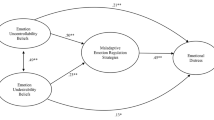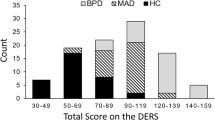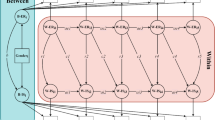Abstract
Affect intolerance (AI), one’s perceived sensitivity to, and intolerance of, unpleasant emotional states, is a risk and maintenance factor of affective disorders. To cope with AI, individuals may rely on maladaptive emotion regulation techniques that provide quick, but short-lived, relief from distress. Two cognitively based maladaptive emotion regulation strategies—repetitive negative thinking (RNT) and thought suppression (TS)—reflect contrasting attempts to cope with unwanted emotions. The present study sought to simultaneously examine the relationships between AI, maladaptive cognitive emotion regulation strategies, and symptoms of mood and anxiety disorders using structural equation modeling. Data from a community sample (N = 590) was used to assess the relationship between an empirically derived latent AI factor and symptoms of depression, anxiety, and obsessive-compulsive disorder (OCD). This latent AI factor demonstrated indirect effects on depression symptoms via RNT (β = 0.212, p = 0.039) and on OCD symptoms via RNT (β = 0.197, p = 0.021) and TS (β = 0.171, p = 0.001). There were no indirect effects of the latent factor on anxiety symptoms. These results suggest that elevated AI is associated with greater psychological symptoms via the use of maladaptive cognitive emotion regulation strategies, and that this relationship differs by symptom type.


Similar content being viewed by others
References
Abramowitz, J. S., Tolin, D. F., & Street, G. P. (2001). Paradoxical effects of thought suppression: a meta-analysis of controlled studies. Clinical Psychology Review, 21(5), 683–703.
Abramowitz, J. S., Whiteside, S., Kalsy, S. A., & Tolin, D. F. (2003). Thought control strategies in obsessive-compulsive disorder: a replication and extension. Behaviour Research and Therapy, 41(5), 529–540.
Amir, N., Cashman, L., & Foa, E. B. (1997). Strategies of thought control in obsessive-compulsive disorder. Behaviour Research and Therapy, 35(8), 775–IN1.
Antony, M. M., Bieling, P. J., Cox, B. J., Enns, M. W., & Swinson, R. P. (1998). Psychometric properties of the 42-item and 21-item versions of the Depression Anxiety Stress Scales in clinical groups and a community sample. Psychological Assessment, 10(2), 176.
Arditte, K. A., Çek, D., Shaw, A. M., & Timpano, K. R. (2016). The importance of assessing clinical phenomena in Mechanical Turk research. Psychological Assessment, 28(6), 684.
Bardeen, J. R., Fergus, T. A., & Orcutt, H. K. (2013). Testing a hierarchical model of distress tolerance. Journal of Psychopathology and Behavioral Assessment, 35(4), 495–505.
Behrend, T. S., Sharek, D. J., Meade, A. W., & Wiebe, E. N. (2011). The viability of crowdsourcing for survey research. Behavior Research Methods, 43(3), 800.
Bernstein, A., Zvolensky, M. J., Vujanovic, A. A., & Moos, R. (2009). Integrating anxiety sensitivity, distress tolerance, and discomfort intolerance: a hierarchical model of affect sensitivity and tolerance. Behavior Therapy, 40(3), 291–301.
Boyce, W. T., & Ellis, B. J. (2005). Biological sensitivity to context: I. an evolutionary–developmental theory of the origins and functions of stress reactivity. Development and Psychopathology, 17(2), 271–301.
Bredemeier, K., McCole, K., Luther, L., Beck, A. T., & Grant, P. M. (2018). Reliability and validity of a brief version of the Intolerance of Uncertainty Scale in outpatients with psychosis. Journal of Psychopathology and Behavioral Assessment, 1–14.
Buhr, K., & Dugas, M. J. (2002). The Intolerance of Uncertainty Scale: psychometric properties of the English version. Behaviour Research and Therapy, 40(8), 931–945.
Calkins, S. D. (1994). Origins and outcomes of individual differences in emotion regulation. Monographs of the Society for Research in Child Development, 59(2–3), 53–72.
Carleton, R. N., Norton, M. P. J., & Asmundson, G. J. (2007). Fearing the unknown: a short version of the Intolerance of Uncertainty Scale. Journal of Anxiety Disorders, 21(1), 105–117.
Carver, C. S., Scheier, M. F., & Weintraub, J. K. (1989). Assessing coping strategies: a theoretically based approach. Journal of Personality and Social Psychology, 56(2), 267.
Chandler, J., & Shapiro, D. (2016). Conducting clinical research using crowdsourced convenience samples. Annual Review of Clinical Psychology, 12.
Clara, I. P., Cox, B. J., & Enns, M. W. (2001). Confirmatory factor analysis of the Depression–Anxiety–Stress Scales in depressed and anxious patients. Journal of Psychopathology and Behavioral Assessment, 23(1), 61–67.
Clark, D. A., & de Silva, P. (1985). The nature of depressive and anxious, intrusive thoughts: distinct or uniform phenomena? Behaviour Research and Therapy, 23(4), 383–393.
Dohrenwend, B. P., Link, B. G., Kern, R., Shrout, P. E., & Markowitz, J. (1990). Measuring life events: the problem of variability within event categories. Stress Medicine, 6(3), 179–187.
Dugas, M. J., & Robichaud, M. (2012). Cognitive-behavioral treatment for generalized anxiety disorder: from science to practice. Routledge.
Dugas, M. J., Hedayati, M., Karavidas, A., Buhr, K., Francis, K., & Phillips, N. A. (2005). Intolerance of uncertainty and information processing: evidence of biased recall and interpretations. Cognitive Therapy and Research, 29(1), 57–70.
Ehring, T., & Watkins, E. R. (2008). Repetitive negative thinking as a transdiagnostic process. International Journal of Cognitive Therapy, 1(3), 192–205. https://doi.org/10.1521/ijct.2008.1.3.192.
Ehring, T., Zetsche, U., Weidacker, K., Wahl, K., Schönfeld, S., & Ehlers, A. (2011). The Perseverative Thinking Questionnaire (PTQ): validation of a content-independent measure of repetitive negative thinking. Journal of Behavior Therapy and Experimental Psychiatry, 42(2), 225–232.
Foa, E. B., Huppert, J. D., Leiberg, S., Langner, R., Kichic, R., Hajcak, G., & Salkovskis, P. M. (2002). The Obsessive-Compulsive Inventory: development and validation of a short version. Psychological Assessment, 14(4), 485.
Hajcak, G., Huppert, J. D., Simons, R. F., & Foa, E. B. (2004). Psychometric properties of the OCI-R in a college sample. Behaviour Research and Therapy, 42(1), 115–123.
Henry, J. D., & Crawford, J. R. (2005). The short-form version of the Depression Anxiety Stress Scales (DASS-21): construct validity and normative data in a large non-clinical sample. The British Journal of Clinical Psychology, 44(2), 227–239.
Jeffries, E. R., McLeish, A. C., Kraemer, K. M., Avallone, K. M., & Fleming, J. B. (2016). The role of distress tolerance in the use of specific emotion regulation strategies. Behavior Modification, 40(3), 439–451.
Laposa, J. M., Collimore, K. C., Hawley, L. L., & Rector, N. A. (2015). Distress tolerance in OCD and anxiety disorders, and its relationship with anxiety sensitivity and intolerance of uncertainty. Journal of Anxiety Disorders, 33, 8–14.
Leyro, T. M., Zvolensky, M. J., & Bernstein, A. (2010). Distress tolerance and psychopathological symptoms and disorders: a review of the empirical literature among adults. Psychological Bulletin, 136(4), 576.
Lovibond, P. F., & Lovibond, S. H. (1995). The structure of negative emotional states: comparison of the Depression Anxiety Stress Scales (DASS) with the Beck Depression and Anxiety Inventories. Behaviour Research and Therapy, 33(3), 335–343.
Magee, J. C., Harden, K. P., & Teachman, B. A. (2012). Psychopathology and thought suppression: a quantitative review. Clinical Psychology Review, 32(3), 189–201.
McHugh, R. K., & Otto, M. W. (2011). Domain-general and domain-specific strategies for the assessment of distress intolerance. Psychology of Addictive Behaviors, 25(4), 745.
McHugh, R. K., & Otto, M. W. (2012). Refining the measurement of distress intolerance. Behavior Therapy, 43(3), 641–651.
Muris, P., Merckelbach, H., & Horselenberg, R. (1996). Individual differences in thought suppression. The White Bear Suppression Inventory: factor structure, reliability, validity and correlates. Behaviour Research and Therapy, 34(5–6), 501–513.
Najmi, S., & Wegner, D. M. (2009). Hidden complications of thought suppression. International Journal of Cognitive Therapy, 2(3), 210–223.
Nolen-Hoeksema, S. (2000). The role of rumination in depressive disorders and mixed anxiety/depressive symptoms. Journal of Abnormal Psychology, 109(3), 504.
Overbeek, T., Schruers, K., Vermetten, E., & Griez, E. (2002). Comorbidity of obsessive-compulsive disorder and depression: prevalence, symptom severity, and treatment effect. The Journal of Clinical Psychiatry.
Purdon, C. (2004). Empirical investigations of thought suppression in OCD. Journal of Behavior Therapy and Experimental Psychiatry, 35(2), 121–136.
Purdon, C., Rowa, K., & Antony, M. M. (2005). Thought suppression and its effects on thought frequency, appraisal and mood state in individuals with obsessive-compulsive disorder. Behaviour Research and Therapy, 43(1), 93–108.
Purdon, C., Gifford, S., McCabe, R., & Antony, M. M. (2011). Thought dismissability in obsessive-compulsive disorder versus panic disorder. Behaviour Research and Therapy, 49(10), 646–653.
Raines, A. M., Vidaurri, D. N., Portero, A. K., & Schmidt, N. B. (2017). Associations between rumination and obsessive-compulsive symptom dimensions. Personality and Individual Differences, 113, 63–67.
Reiss, S., Peterson, R. A., Gursky, D. M., & McNally, R. J. (1986). Anxiety sensitivity, anxiety frequency and the prediction of fearfulness. Behaviour Research and Therapy, 24(1), 1–8.
Salkovskis, P. M., & Campbell, P. (1994). Thought suppression induces intrusion in naturally occurring negative intrusive thoughts. Behaviour Research and Therapy, 32(1), 1–8.
Shaw, A. M., Llabre, M. M., & Timpano, K. R. (2015). Affect intolerance and hoarding symptoms: a structural equation modeling approach. International Journal of Cognitive Therapy, 8(3), 222–238.
Taylor, S., Zvolensky, M. J., Cox, B. J., Deacon, B., Heimberg, R. G., Ledley, D. R., et al. (2007). Robust dimensions of anxiety sensitivity: development and initial validation of the Anxiety Sensitivity Index-3. Psychological Assessment, 19(2), 176.
Wegner, D. M., & Zanakos, S. (1994). Chronic thought suppression. Journal of Personality, 62(4), 615–640.
Wegner, D. M., Schneider, D. J., Carter, S. R., & White, T. L. (1987). Paradoxical effects of thought suppression. Journal of Personality and Social Psychology, 53(1), 5.
Wenzlaff, R. M., Wegner, D. M., & Roper, D. W. (1988). Depression and mental control: the resurgence of unwanted negative thoughts. Journal of Personality and Social Psychology, 55(6), 882.
Zeman, J., Cassano, M., Perry-Parrish, C., & Stegall, S. (2006). Emotion regulation in children and adolescents. Journal of Developmental and Behavioral Pediatrics, 27(2), 155–168.
Author information
Authors and Affiliations
Corresponding author
Ethics declarations
Conflict of Interest
The authors declare that they have no conflict of interest.
Additional information
Publisher’s Note
Springer Nature remains neutral with regard to jurisdictional claims in published maps and institutional affiliations.
Rights and permissions
About this article
Cite this article
Jaso, B.A., Hudiburgh, S.E., Heller, A.S. et al. The Relationship Between Affect Intolerance, Maladaptive Emotion Regulation, and Psychological Symptoms. J Cogn Ther 13, 67–82 (2020). https://doi.org/10.1007/s41811-019-00061-7
Published:
Issue Date:
DOI: https://doi.org/10.1007/s41811-019-00061-7




